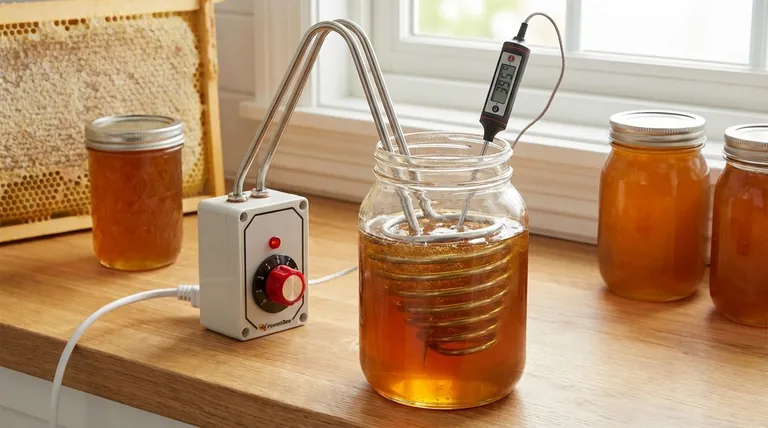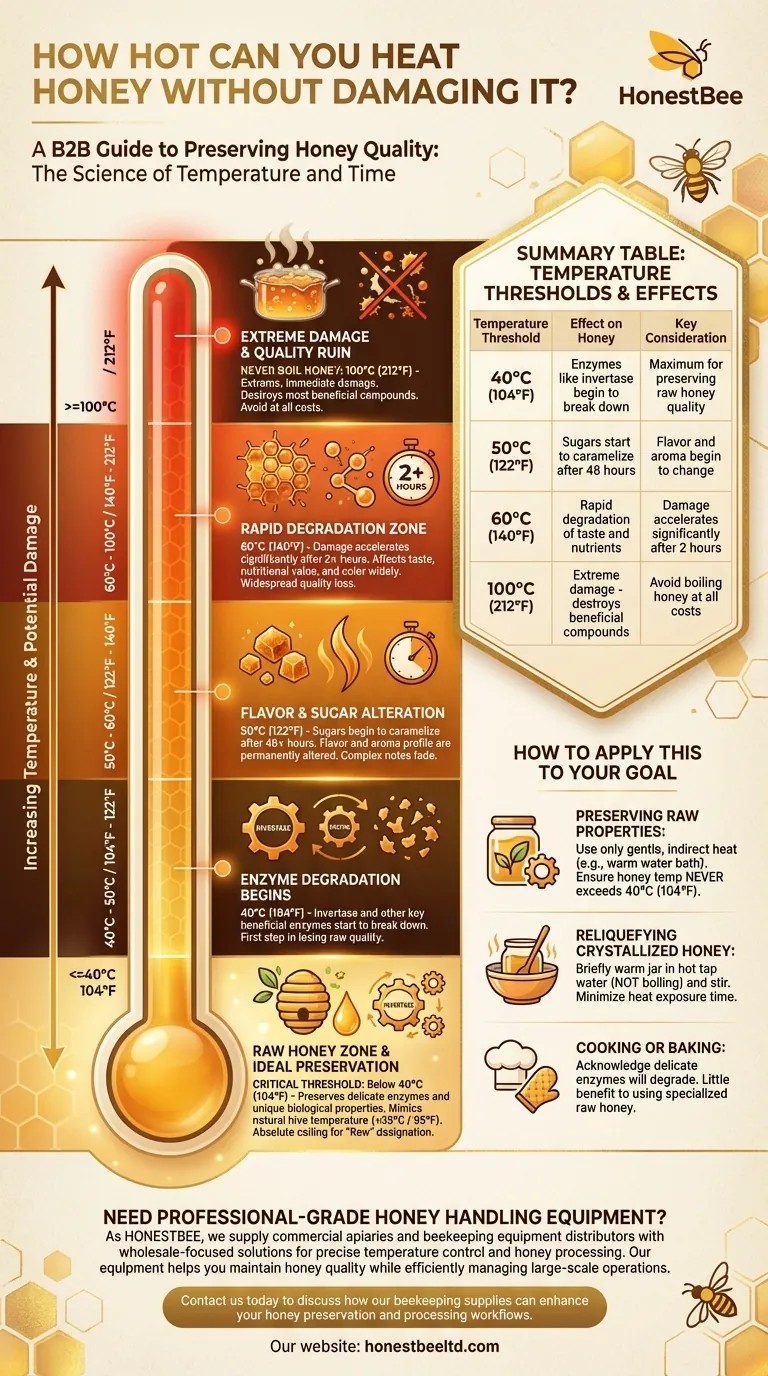To preserve its most delicate properties, honey should not be heated above 40°C (104°F). This is the critical threshold where beneficial enzymes like invertase begin to break down. While higher temperatures can be used for very short periods to reliquefy honey, any heat application involves a trade-off between convenience and the degradation of its natural quality.
The "damage" temperature for honey is not a single number, but a series of thresholds. The true factors are a combination of temperature and time, with higher heat causing more rapid degradation of enzymes, flavors, and valuable sugars.
What "Damaging" Honey Actually Means
When we talk about damaging honey with heat, we are referring to several distinct types of degradation that occur at different temperatures and durations.
The Loss of Key Enzymes
The most immediate and sensitive components to be damaged are enzymes. The reference to 40°C (104°F) is the point at which invertase, an enzyme bees add to honey, begins to be destroyed.
These enzymes are often considered a primary marker of raw, unprocessed honey. Their loss is the first step in stripping honey of its unique biological properties.
Altering Sugars and Flavor
As the heat and duration increase, the fundamental structure of the honey begins to change.
Heating honey to 50°C (122°F) for over 48 hours will begin to caramelize its sugars. This process permanently alters the flavor and aroma, turning the complex profile of honey into something more analogous to simple sugar syrup.
The Point of Rapid Degradation
There is a point where the damage accelerates significantly, impacting the overall quality on a wider scale.
Exposing honey to temperatures higher than 60°C (140°F) for more than two hours will cause rapid and widespread degradation. At this stage, the damage goes far beyond just the most sensitive enzymes, affecting the honey's taste, nutritional value, and color.
Understanding the Trade-offs
Heating honey is always a balancing act. The key is to understand that temperature and time have an inverse relationship: the higher the heat, the less time it takes to cause damage.
The "Raw Honey" Standard
For those who wish to preserve honey in its natural state, any temperature above natural hive temperature (around 35°C or 95°F) is a compromise. The 40°C (104°F) limit is the absolute ceiling for maintaining its "raw" designation and enzymatic activity.
The Goal of Reliquefaction
Most people heat honey for one reason: to turn it from a solid, crystallized state back into a liquid. This can be done safely, but it requires gentle, indirect heat and careful monitoring to avoid creating hot spots that exceed these critical temperature limits.
What to Avoid at All Costs
Never boil honey. Boiling occurs at 100°C (212°F), a temperature that will cause extreme and immediate damage, destroying most of its beneficial compounds and ruining its quality. The advice to avoid excessive heat in a "press" underscores that even in industrial settings, high temperatures are detrimental.
How to Apply This to Your Goal
Your approach to heating honey should be dictated entirely by your end goal.
- If your primary focus is preserving raw, enzymatic properties: Use only gentle, indirect heat, such as a warm water bath, ensuring the temperature of the honey itself never exceeds 40°C (104°F).
- If your primary focus is to reliquefy crystallized honey: Briefly warm the jar in a bowl of hot tap water (not boiling) and stir until smooth, minimizing its exposure time to heat.
- If you are using honey in cooking or baking: Acknowledge that the temperatures involved will degrade its delicate enzymes, so there is little benefit to using a specialized raw honey for these applications.
By understanding the relationship between heat, time, and degradation, you can handle your honey with the precise care required for your purpose.

Summary Table:
| Temperature Threshold | Effect on Honey | Key Consideration |
|---|---|---|
| 40°C (104°F) | Enzymes like invertase begin to break down | Maximum for preserving raw honey quality |
| 50°C (122°F) | Sugars start to caramelize after 48 hours | Flavor and aroma begin to change |
| 60°C (140°F) | Rapid degradation of taste and nutrients | Damage accelerates significantly after 2 hours |
| 100°C (212°F) | Extreme damage - destroys beneficial compounds | Avoid boiling honey at all costs |
Need professional-grade honey handling equipment? As HONESTBEE, we supply commercial apiaries and beekeeping equipment distributors with wholesale-focused solutions for precise temperature control and honey processing. Our equipment helps you maintain honey quality while efficiently managing large-scale operations.
Contact us today to discuss how our beekeeping supplies can enhance your honey preservation and processing workflows.
Visual Guide

Related Products
- Professional Thermostatic Conical Honey Melter
- 10L Stainless Steel Electric Honey Press Machine
- Honey Concentrating Vacuum Heating Thickening Machine Dehumidifier for Honey
- 8-Frame Electric Self-Reversing Honey Extractor Spinner for Commercial Honey Extraction Equipment
- Economy Small Scale Honey Dryer Dehumidifier Thickening Machine
People Also Ask
- How does the Bee Blanket help maintain honey quality? Preserve Enzymes with Gentle Hive-Mimicking Heat
- What is the effect of heating on honey? Preserve Quality with Controlled Warming
- Why is heating honey sometimes necessary? The Essential Guide to Processing & Quality
- Is it safe to heat crystallized honey? Restore Your Honey's Liquid State Safely
- How to permanently decrystallize honey? Embrace Its Natural State for Maximum Quality



















